Exam Details
Exam Code
:JN0-643Exam Name
:Enterprise Routing and Switching, Professional (JNCIP-ENT)Certification
:Juniper CertificationsVendor
:JuniperTotal Questions
:287 Q&AsLast Updated
:Mar 24, 2025
Juniper Juniper Certifications JN0-643 Questions & Answers
-
Question 71:
-- Exhibit

-- Exhibit -Click the Exhibit button.
In the exhibit, an EBGP session is currently established between R1 and R2. R2 changes its import policy to accept 10 of the routes it previously denied from R1.
Which BGP capability must be negotiated on the BGP session for R2 to install the routes accepted by the new policy?
A. route refresh
B. AddPath
C. outbound route filtering (ORF)
D. multiprotocol BGP (MBGP)
-
Question 72:
-- Exhibit -
{master:0}[edit] user@router# run show ospf interface vl-10.20.10.2 extensive Interface State Area DR ID BDR ID Nbrs vl-10.20.10.2 Down 0.0.0.0 0.0.0.0 0.0.0.0 0 TypE. Virtual, Address: 0.0.0.0, Mask: 0.0.0.0, MTU: 0, Cost: 1 Transit AreA. 0.0.0.1 Adj count: 0 Hello: 10, DeaD. 40, ReXmit: 5, Not Stub Auth typE. None Protection typE. None, No eligible backup Topology default (ID 0) -> Down, Cost: 0 -- Exhibit -
Click the Exhibit button.
Your company is integrating another OSPF area into your existing OSPF infrastructure. You created a virtual link that spans Area 2 and connects Area 3 to the backbone area.
Based on the exhibit, what is preventing the adjacency?
A. The interface configured for the virtual link is incorrect. It should be a vt and not a vl interface.
B. No designated router (DR) has been elected.
C. The backup route to Area 2 has not been configured.
D. The wrong transit area is configured.
-
Question 73:
-- Exhibit -- Exhibit -
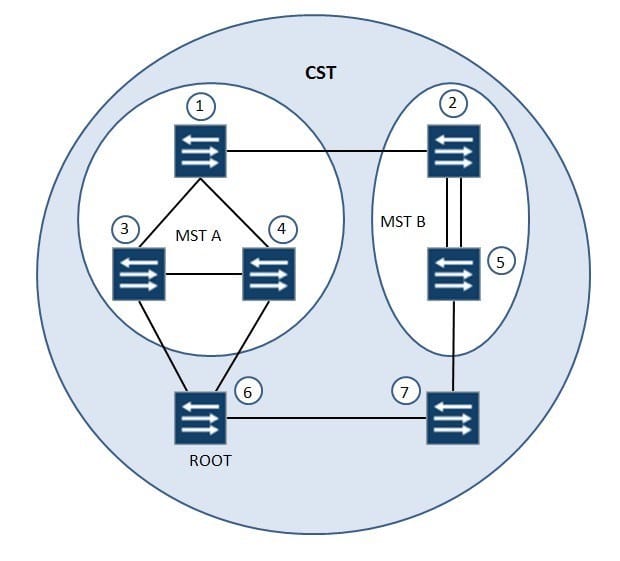
Click the Exhibit button.
Based on the exhibit, which statement about the Layer 2 topology is true?
A. A port on switch 3 or switch 4 towards the CST root (switch 6) is blocking traffic.
B. A total of 64 MST instances for MST region A and region B can be configured.
C. MSTI BPDUs are exchanged between MST regions and the CST root bridge.
D. IST BPDUs are exchanged only between switches 1 and 2, and between switches 6 and 7.
-
Question 74:
-- Exhibit
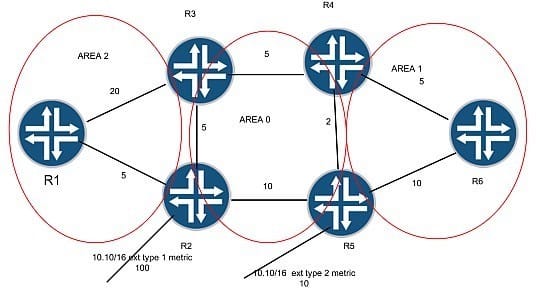
-- Exhibit -
Click the Exhibit button.
As shown in the exhibit, the 10.10/16 prefix is redistributed into OSPF through R2 and R5. R2 is advertising the prefix with a Type 1 metric of 100 and R5 is advertising the prefix with a Type 2 metric of 10.
What is the preferred path to reach 10.10/16 from R6?
A. R6-R5
B. R6-R4-R5
C. R6-R4-R5-R2
D. R6-R4-R3-R2
-
Question 75:
-- Exhibit
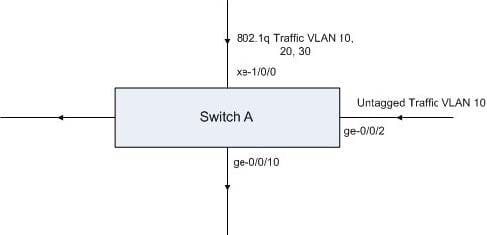
-- Exhibit -Click the Exhibit button. In the exhibit, Switch A is an EX4200. VLAN10 is receiving tagged as well as untagged traffic from different ports. The administrator wants to mirror all tagged and untagged traffic entering VLAN10 to analyzer port ge-0/0/10. All VLAN tags
must be preserved for traffic that is mirrored to the analyzer port. Which configuration will achieve this?
A. set ethernet-switching-options analyzer vlan10_analyzer input vlan VLAN10 interface xe- 1/0/0.0 set ethernet-switching-options analyzer vlan10_analyzer input vlan VLAN10 interface ge-0/0/2 set ethernet-switching-options analyzer vlan10_analyzer output interface ge-0/0/10.0
B. set ethernet-switching-options analyzer vlan10_analyzer input interface xe-1/0/0.0 set ethernet- switching-options analyzer vlan10_analyzer input interface ge-0/0/2 set ethernet-switching-options analyzer vlan10_analyzer output interface ge-0/0/10.0
C. set ethernet-switching-options analyzer vlan10_analyzer input ingress vlan VLAN10 set ethernet- switching-options analyzer vlan10_analyzer output interface ge-0/0/10.0 set vlans default interface ge- 0/0/10.0
D. set ethernet-switching-options analyzer vlan10_analyzer input ingress vlan VLAN10 set ethernet- switching-options analyzer vlan10_analyzer output interface ge-0/0/10.0 set vlans VLAN10 interface ge-0/0/10.0
-
Question 76:
-- Exhibit
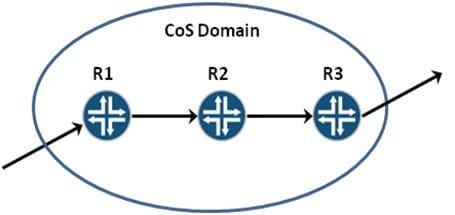
-- Exhibit -
Click the Exhibit button.
Traffic flows through your network, as shown in the exhibit. You have configured a rewrite rule on R1 to mark HTTP traffic with a specific DSCP value.
What must you do to ensure that the HTTP traffic preserves its DSCP value as it leaves your CoS domain?
A. Use behavior aggregate classifiers mapping the HTTP traffic to the specific DSCP value on R1 and R2.
B. Use rewrite rules mapping the HTTP traffic to the specific DSCP value on R2 and R3.
C. Use a rewrite rule mapping the HTTP traffic to the specific DSCP value on R3.
D. Use the default settings already in place on the device.
-
Question 77:
-- Exhibit

-- Exhibit -Click the Exhibit button.
In the topology shown in the exhibit, which two BGP attributes can AS1 manipulate to influence the path that AS4 takes to reach prefixes originated by AS1? (Choose two.)
A. Local Preference
B. AS Path
C. Origin
D. MED
-
Question 78:
-- Exhibit

-- Exhibit -
Click the Exhibit button.
In the exhibit, the provider bridges are using Q-in-Q tunneling to tunnel VLAN 100 traffic over VLAN 200. What is the correct VLAN configuration for Q-in-Q tunneling on Provider Bridge A?
A. interfaces { ge-0/0/0 { unit 0 { family ethernet-switching { port-mode access; } } } ge-0/0/10 { unit 0 { family ethernet-switching { port-mode trunk; vlan { members test; } } } } } vlans { test { vlan-id 200; interface { ge-0/0/0.0; } dot1q-tunneling { customer-vlans 100; } }
}
B. interfaces { ge-0/0/0 { unit 0 { family ethernet-switching {
port-mode trunk;
vlan {
members test;
}
}
}
}
ge-0/0/10 {
unit 0 {
family ethernet-switching {
port-mode access;
}
}
}
}
vlans {
test {
vlan-id 200;
interface {
ge-0/0/0.0;
}
dot1q-tunneling {
customer-vlans 100;
}
}
}
C. interfaces { ge-0/0/0 { unit 0 { family ethernet-switching { port-mode trunk; vlan { members test; } } } } ge-0/0/10 { unit 0 { family ethernet-switching { port-mode access; } } } } vlans { test { vlan-id 200; interface { ge-0/0/10.0; } dot1q-tunneling { customer-vlans 100; } } }
D. interfaces { ge-0/0/0 { unit 0 { family ethernet-switching { port-mode access; } } } ge-0/0/10 { unit 0 { family ethernet-switching { port-mode trunk; vlan { members test; } } } } } vlans { test { vlan-id 100; interface { ge-0/0/0.0; } dot1q-tunneling { customer-vlans 200; } } }
-
Question 79:
-- Exhibit
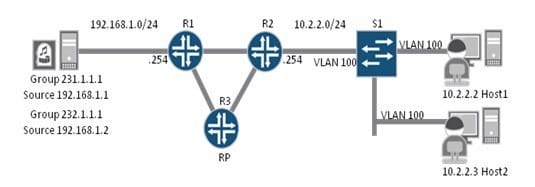
-- Exhibit -Click the Exhibit button. In the exhibit, the routers in the network have a default PIM sparse mode configuration. R2 shows that R1 is the RPF next hop for the source, and R3 is the RPF next hop for the RP. Host1 is currently receiving multicast traffic for group
231.1.1.1. Host2 has come online and is attempting to join group 232.1.1.1. R2 has just received an IGMP message with the source and group addresses. Which step happens next so that Host2 can join the multicast group?
A. R2 sends a PIM join upstream towards R3 to join the shared tree.
B. R2 sends a PIM join upstream towards R3 to join the source tree.
C. R2 sends a PIM join upstream towards R1 to join the shared tree.
D. R2 sends a PIM join upstream towards R1 to join the source tree.
-
Question 80:
-- Exhibit
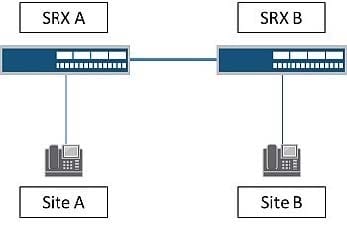
-- Exhibit -Click the Exhibit button.
Site A is sending voice traffic marked with DSCP code EF. SRX A has the default CoS classifier.
Into which forwarding class is SRX A classifying traffic?
A. best-effort
B. expedited-forwarding
C. network-control
D. assured-forwarding
Related Exams:
JN0-102
Internet Associate, Junos(JNCIA-Junos)JN0-104
Junos, Associate (JNCIA-Junos)JN0-105
Junos, Associate (JNCIA-Junos)JN0-1101
Juniper Networks Certified Design Associate (JNCDA)JN0-130
Juniper networks Certified internet specialist.e(jncis-e)JN0-1301
Data Center Design, Specialist (JNCDS-DC)JN0-1302
Data Center Design Specialist (JNCDS-DC)JN0-1331
Security Design, Specialist (JNCDS-SEC)JN0-1332
Security Design, Specialist (JNCDS-SEC)JN0-1361
Service Provider Design Specialist (JNCDS-SP)
Tips on How to Prepare for the Exams
Nowadays, the certification exams become more and more important and required by more and more enterprises when applying for a job. But how to prepare for the exam effectively? How to prepare for the exam in a short time with less efforts? How to get a ideal result and how to find the most reliable resources? Here on Vcedump.com, you will find all the answers. Vcedump.com provide not only Juniper exam questions, answers and explanations but also complete assistance on your exam preparation and certification application. If you are confused on your JN0-643 exam preparations and Juniper certification application, do not hesitate to visit our Vcedump.com to find your solutions here.